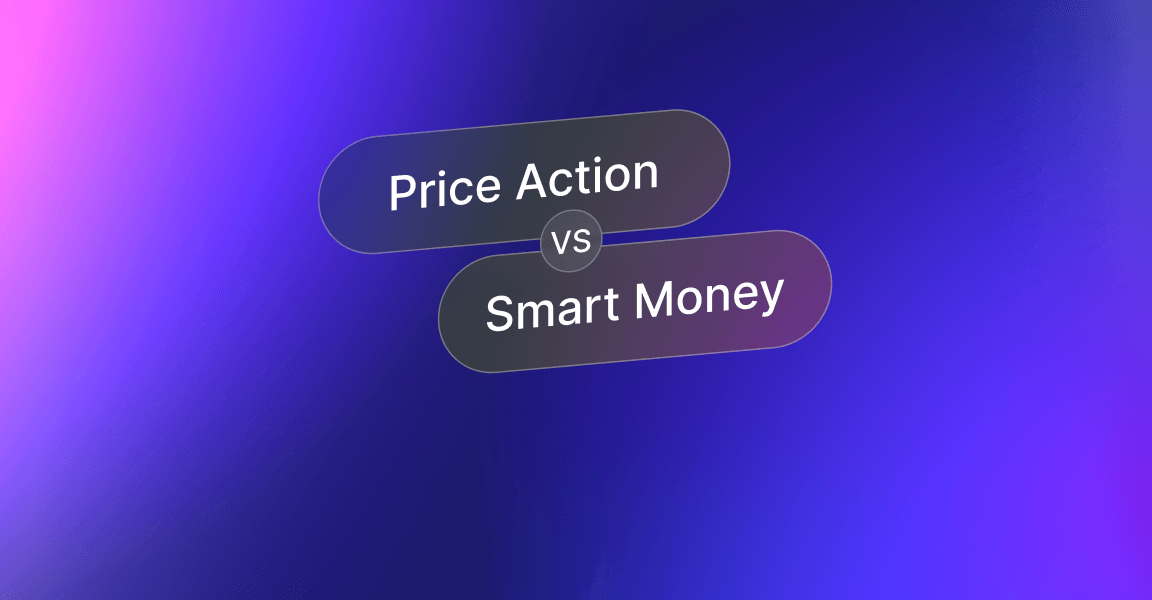Price Action vs Smart Money Concepts (SMC) in Trading


Welcome to the world of forex and crypto trading. Here’s one detail: two popular approaches that stand out, Smart Money Concepts (SMC) and Price Action. And the main discussion is always about Smart Money Concepts or Price Action. This article will determine it.
Smart Money Concepts (SMC) focuses on analyzing market movements driven by institutional investors, often called “smart money.” This concept relies on identifying key levels where smart money participants are likely to enter or exit positions, using tools such as moving averages (MA) to smooth out price data and identify trends.
Price Action, on the other hand, involves analyzing historical price movements to make trading decisions. It disregards indicators and focuses solely on price patterns and market structure to identify potential trading opportunities.
It’s time to compare SMC vs Price Action. While SMC relies heavily on moving averages and other indicators to interpret market behavior, Price Action focuses on pure price movement without the use of indicators. In advance, SMC aims to align with institutional traders, whereas Price Action traders react to market behavior based on historical price patterns.
Let’s get deeper and conduct a brief analysis of the pros and cons of SMC.

Using SMC in trading has several advantages. First, it helps in identifying the trend direction, making it easier for traders to align their trades with the market direction. Moving averages reduce market noise, providing a clearer picture of the underlying trend. Moreover, following smart money can position traders in alignment with institutional strategies, potentially leading to more profitable trades.
Despite its advantages, SMC has some limitations. Moving averages are lagging indicators, meaning they reflect past price movements and may not provide timely signals. This can result in false signals during choppy or sideways markets. Additionally, understanding and effectively using SMC requires a deep knowledge of institutional trading behavior and significant market experience.
Price Action trading is a widely adopted approach in the professional world. Let’s find out what its profit is and what its substantial risk is.

Price Action trading offers simplicity, relying on clean charts without clutter from multiple indicators. It provides real-time insights based on current market behavior, making it a highly responsive approach. Furthermore, it is versatile and can be applied to any market or time frame, making it a flexible strategy for traders.
However, Price Action has its own set of challenges. The interpretation of price patterns can be subjective and may vary between traders, leading to inconsistencies. Effective Price Action trading requires a good understanding of marketbehavior and practice. Additionally, since it relies on historical data, it may not always predict future movements accurately.
Developing effective trading strategies involves understanding and leveraging the strengths of both Smart Money Concepts and Price Action. Each approach offers unique insights and techniques that can be used independently or combined for greater effectiveness. Let’s explore the various strategies that utilize these two options to maximize trading profitability.
There are several popular trading systems that utilize SMC. For example, trend-following strategies use moving averages to identify and follow trends. A common approach is to use the 50-day and 200-day moving averages to spot long-term trends. Another strategy is breakout trading, which involves identifying key levels where institutional traders are likely to place significant orders and trading breakouts from these levels.
“Moving averages are a powerful tool for identifying the direction of the trend and reducing market noise, making it easier for traders to align their trades with the market direction.” — Investopedia
Price Action also offers a variety of effective strategies. One such strategy is trading based on support and resistance levels identified from historical price data. Traders also use candlestick patterns, like pin bars, inside bars, and engulfing bars, to make trading decisions. Additionally, drawing trend lines to identify potential reversal or continuation points is a common technique.
“Price action trading eliminates the need for lagging indicators and focuses on historical price data, allowing traders to make decisions based on the most recent market movements.” — BabyPips
It is a good idea to connect these options – it can provide a more comprehensive trading strategy. For example, a trader might use moving averages to identify the trend direction (SMC) and then use price patterns to time entries and exits (Price Action).
A hybrid strategy might involve using the 200-day moving average to identify the overall trend direction. The trader can then use Price Action patterns, such as pin bars or engulfing bars, to time entries in the direction of the trend. Risk management is crucial, and stop-loss orders should be placed based on recent swing highs or lows to manage risk effectively.
To effectively apply SMC and Price Action in trading, traders should stay informed about market news and institutional behavior. Practicing these strategies using demo accounts can help traders gain experience and confidence. Risk management is essential; always use stop-loss orders and manage risk carefully. Keeping a trading journal to analyze trades and improve strategies is also recommended.
Effective risk and capital management are crucial for long-term success in trading. Traders should only risk a small percentage of their capital on any single trade and diversify their portfolio to spread risk. By creating a complex of these two, traders can create robust strategies that leverage the strengths of both approaches, leading to better trading decisions and improved profitability.
“Combining different trading strategies, such as SMC and Price Action, can enhance trading effectiveness by offering multiple perspectives on market behavior.” — Trading Strategy Guides
Understanding and applying Smart Money Concepts and Price Action in trading can significantly enhance a trader’s effectiveness. By leveraging the strengths of both approaches and implementing sound risk management practices, traders can achieve better results and increase their chances of success in the financial markets.